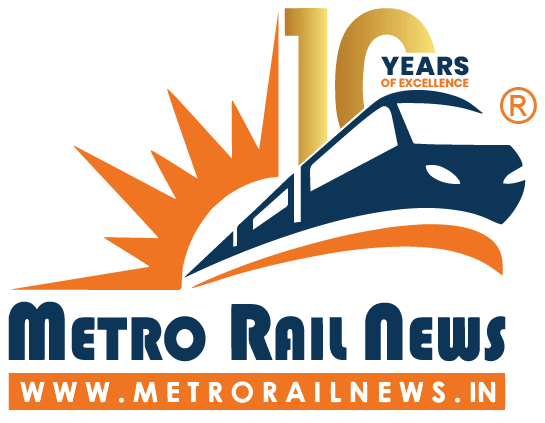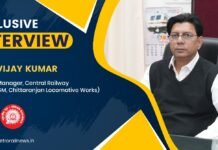Metro Rail News team Conducted an email interview with Mr Dipankar Ghosh that entails a very significant issue of improvements in Rolling stock. The interview also aims to explore the current trends like Make in India & AI for the Indian Rail Sector, along with underlining the future plans of Knorr Bremse for the production and mobility sector in India.
Mr Dipankar Ghosh, MD of Knorr Bremse India and Chairman of the Railway Equipment Division of CII, possesses 30+ years of diverse experience encompassing manufacturing, engineering management, and business development. As an ex-IRSEE officer and former CEO of Escorts Railways Division, he led major global initiatives, facilitating technology transfers and adopting frugal innovation strategies. Holding a postgraduate engineering degree from BITS Pilani and a management qualification from the Indian School of Business, he is also an Advanced Global Leadership alumnus of the London School of Economics. Mr. Ghosh is passionate about new technologies and a dedicated proponent of value engineering.
Here are the edited excerpts
Q.1. Where do you think IR still needs to make enhanced and continued improvements in its rolling stock fleet for superior train operations both for its passenger and freight transportation?
Answer: My personal opinion is that given the operational challenges for the size and the spread of the Indian Railway network and the stringent safety requirements, Railways, even globally, are very conservative in technology adoption and for a passenger operation of primarily within 160KMPH, IR does have a decent technology infusion in the Rolling stock space starting with LHB coaches Technology Transfer way back in 2000s, while the new Vande Bharat Platform Trainsets with different configurations (both Stainless Steel and Aluminum Car body) and with the Private Sector both Indian car builders like TWL, and the global players like AT and TMI do fill up the gaps in Rolling Stock Technology canvas for the passenger segment.
The upcoming MAHSR High-speed project will give a massive fillip to the High-Speed Segment, which is absent now, and hopefully usher in more high-speed corridors in the country in the coming years.
In the Loco segment, the 3 phase Electric Locomotives built at CLW, BLW and other Railway factories and now the 12000 HP Double loco from the Alstom Madhepura project, the GE Wabtec Marhowa Project and the recent upcoming 9000 HP Siemens Loco to be manufactured in Dahod, Gujarat almost completes the gap in Locomotive segment.
For the freight segment, the Indian Private Wagon Builders, together with RDSO, have the required depth in the Freight Wagon design, which is sufficient with the present operating speeds till maybe another decade when the freight operating speeds reach above 160KMPH, even though Wagon designs tailored for specific Industry use and use of innovative material for lighter Tare weight wagons is a need.
The major bottleneck for increasing operating speed in IR is still the mixed mode traffic, much slower Freight Trains slowing down the Faster express Trains in the same route, so network debottlenecking through the upcoming Dedicated Freight Corridor is critical. Railways have more than 60% of routes being more than 100% utilized.
Besides better signalling infrastructure like the ETCS Level 2 or similar homegrown systems for much higher Throughputs, increase the use of KAVACH for safety, the elimination of Road Crossings, use of high-speed turnouts, reduction of curves and gradients with Tunnels and Viaducts and improving the bridges and other permanent way infrastructure to cater to a higher average speed of operations for both passenger and freight segments besides ensuring safety.
Q2. As a veteran in the Railway Industry, how do you see the future of Mobility evolve in India vis-a-vis European Rail Market?
Answer: The world is witnessing a trend of massive urbanization – While the world’s total population is expected to increase from 7 to 8.3 billion people in 2030, the urbanization growth rate is expected to be 2 % per year, representing 60 % of the world population or 5 billion people in 2030. With the Increasing urbanization ~ Growth of “megacities” with more than 50 million people across different countries, particularly India, China will be a reality soon.
This urbanization trend will continue to create massive and rapid pressure on mass transit systems since, as per the OECD and World Bank reports, around 80% of the world’s population will live in cities by 2050.
Along with this Urbanization, we would have a growing urban middle class who would be increasingly sophisticated and web-connected consumers who will demand a better customer experience in Mobility, leading to another dimension for this challenge. Fast, inexpensive, and efficient transportation will be vital to meeting those population growth demands.
The millions of Smartphones with passengers will create opportunities to provide personalized services to individual users and be rich data sources for Mobility Solution algorithms to optimize and customize the mobility solution offerings.
Imagine the disruption when the Sensors installed in cities get a more precise vision of their “context” or Data augmented in Smart cities like Open data Maps and Real-Time Transport data is integrated into these mobility algorithms, which will create the magic of passenger experiences.
The trend in Mobility with this backdrop, which is already seen in Europe, China would become a reality in India in the next few years is as follows:
Changing Passenger expectations –
• From when and where people travel to the Quality of Service & Passenger Experience.
• Transport to be delivered as an on-demand, multi-modal service that allows passengers to travel door-to-door conveniently and seamlessly.
Sharing economy and co-existence of different transport modes –
• From sole ownership to temporary ownership.
• Co-existence of Shared electric cars and minibuses, electric bikes as well as more traditional public transport services, support easy both first and last mile(s) access,
• Seamless multiple shared-mobility options where private, shared, and public transport boundaries are blurred.
This convergence through digitalization would evolve into Mobility as a Service (MaaS), where Mobility would be delivered through a combination of self-driving, shared vehicles, with high-quality public transit like Railways Metros, RRTS and other Mass Transit Systems as the main backbone.
Given that Railways and Metros are fixed transport systems, the rail industry will not replicate the success of Uber so that consumers can summon trains.
Railways & Metros, RRTS, by adopting a user-centric approach that focuses more on its passengers, can unlock Seamless and Frictionless travel, solve the ‘Last mile’ & the First-mile puzzle, and integrate with other modes of Transport.
It is already a reality in many countries of Europe and has been very successful and has improved the usage of Railways and Metros significantly.
The Mobility of the future will be flexible and integrated and offer on-demand services to serve customer demand. It would be enabled by combining public and private transportation services through a unified gateway by Mobility Aggregator. It will help the customer create and manage the end-to-end trip, which users can pay with a single account.
Customers can choose and pay for an entire end-to-end journey using different transport modes, buses, distance Trains, Metros and an Uber or Ola cab as the last mile portion, all through a single platform.
Q.3 What have been your major initiatives under the ‘Make in India’ and ‘Atmanirbhar Bharat Abhiyan’?
Knorr-Bremse India (KBI), a wholly-owned subsidiary of the German MNC – Knorr-Bremse AG, has been in India for almost 40 years.
KBI has been the pioneer for the last 26 years in bringing high-end technology from across the world for Indian Railways and Metros for Braking Systems, Passenger Doors, Sanitary Systems, HVACs and Power Electrics and is a true example of our Honorable Prime Minister’s vision for Make in India.
We also have the privilege of partnering with Indian Railways for the very prestigious projects of Vande Bharat Trains and Alstom Madhepura Double Locomotives. We are very proud that ICF has given us the privilege to be one of the major suppliers for the Vande Bharat trains for Brakes, Doors, Sanitary Systems and now also different TCMS solutions.
We have introduced high-end vacuum toilet systems similar to the Aircraft toilet systems in the Vande Bharat Trains with European quality but at Indian prices through extensive localization.
We have also introduced some of the latest technology, like the Linear Induction motor Door drive system in India for the Medha Mumbai Monorail Project.
With our ongoing expansion plans, KBI would even set the example for “Local for Global” as we are manufacturing in India for many global railway projects from our factory in Palwal, Haryana, besides contributing to the Railway modernization plan through continuous Technology infusion.
In the coming years, as we complete our new factory, we will be manufacturing Doors, HVAC, Sanitary Systems, and other subsystems for many of our Global Railway projects across the world from our KB India plant.
Q.4 How do you see the use of DATA and AI transforming the Railways both in India and Globally?
Globally, Railways are also in the midst of a profound transformation, driven by the confluence of emerging digital technologies like 5G, Big Data, the Internet of Things and now the Internet of Trains, AI, Blockchain and the use of Augmented Reality/Virtual Reality.
With the confluence of 4 Global megatrends, namely the availability of inexpensive sensors, robust yet cheap Cloud computing through Amazon Web Services, Microsoft Azure, the symbiotic convergence of Big Data and AI to analyze enormous datasets into actionable insights and the availability of the wireless connectivity has helped the Railways operators globally to shift from a reactive traditional Time-based monitoring to condition-based monitoring and predictive maintenance of all their critical railways assets.
Railway Operators have troves of raw data which, combined with powerful and sophisticated analytics and AI Machine learning like Deep Learning tools, can yield valuable insights so that their decisions no longer have to be made in the dark or based on gut instinct; they can be based on evidence, experiments, and more accurate forecasts and incorporate data-driven insights into day-to-day business processes.
Smart detectors fitted in axle counters, track circuits, point machines, signals, Axles, Bogies and brakes, Door Systems, HVAC Filters, Wheels, Wheel bearings, and Pantographs can sense any flaws or abnormal behaviour that can be detected.
Piezoelectric axle-mounted sensors can measure the peak load exerted by railway carriages as they pass over the tracks. As a function of time and location, historical data is available in track geometry and fluctuations underneath the carriages. The data is translated into defect measurements. Hence, any developing faults are sensed well in advance. The remaining life of tracks and wheels is predicted almost accurately.
The sensors, embedded into various train subsystems, potentially measure and monitor the behaviour of almost all subsystems and generate vast volumes of data, which can be collected and analyzed 24 hours a day, seven days a week, creating a Digital Nervous System of the Train using Wireless Sensor Nodes or the internet of Trains.
Track condition monitoring using a combination of fibre optic sensing and other wireless sensor nodes, Railway Bridge health monitoring through Wireless sensor nodes and related Analytics.
With the present predictive analytics technology available, it’s possible to proactively manage maintenance and improve operational efficiency by discovering the chance of a failure before it takes place, leading to predictive insight for reducing operational risk, controlling maintenance costs, and discovering patterns related to recurring problems by using machine learning to predict KPIs such as Remaining Useful Life, Time to Failure, and Failure within a specific time, etc.
Q.5 As an experienced railway industry professional and an ex-IRSEE officer, what would be your message to young technocrats willing to join the mobility market, the metro and rail industry? Also, kindly share your views on Metro Rail News and our annual tech event InnoMetro.
Today, India is at the confluence of several megatrends like massive internet penetration across the country in both rural and urban sectors – Internet penetration in India has increased fourfold in the past decade, rising from 12.6 per cent penetration nationwide in 2012 to 48.7 per cent penetration in 2022 to almost 700Mn users, on the other hand, price of data has fallen exponentially & use of smartphones increased exponentially in the country.
The Massive surge in Digital Payments, formalization of the economy, and Networking of the whole Indian economy have opened up multiple opportunities for the government and the private sector to bring innovative business models to the Railway sector.
India has also emerged as the 3rd largest Tech Startup ecosystem in the world and has produced over 180 unicorns with billion-plus valuations in the last few years. With this vibrant tech startup ecosystem, finding innovative solutions to the present-day mobility challenges in India would be easy.
The Demographic Dividend, or the working age population from 20 to 55 years in India, will be the maximum globally for the next 2/3 decades – the same sweet spot enjoyed by Japan in 1964, South Korea in 1967 and China in 1994. We have the most significant English-speaking STEM graduates in the world now.
With this backdrop and since each of these triggers reinforces each other, we have an ecosystem ripe for both the Govt and the private sector and the individual entrepreneur to look for the different gaps in the existing ecosystem in the consumer experience and safety solutions.
Given the resilience and persistence of the average Indian entrepreneur to overcome different challenges in the business ecosystem, I feel we can create many innovative solutions for Indian consumers. My advice to both the young entrepreneurs and the people in the government sectors is that with such an environment and the fact that the present government and the Railways and Metros are very open to looking for newer solutions to the different existing gaps -the sky is the limit in this mobility segment with substantial future growth possibilities.





